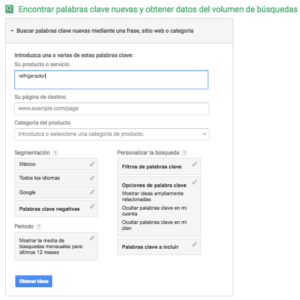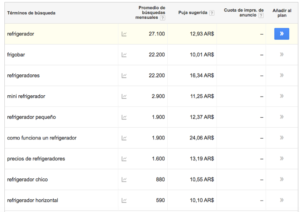Keywords are the words that people use to search in Google. We must use them when generating content for users to understand our products or services and so that they can find us within the first results in search engines.
These words show us which are the intentions that a person has when performing a search and that is why it is so important to obtain positioning in Google for them.
Now, the selection of keywords should always be oriented to the marketing objectives of the company, and at the same time, be related to the user’s interests, because from these will emerge the searches made on Google.
But how do you know which keywords users are searching for?
To answer this question, we will resort to one of the most popular tools in the digital environment and widely used in SEO: Google Adwords Keyword Planner.
This platform provides us with data directly from Google, remember that in Mexico 98% of the population chooses to use this search engine.
Within the information provided by the keyword planner, we can obtain keywords used by users and the number of monthly searches.
Let’s see an example:
Let’s suppose you have an appliance store, and therefore a variety of products to sell. In the tool we enter as a keyword a product category, such as “refrigerator“, and activate the parameters we consider necessary for the search:

As a result, the tool will tell us which are keywords related to the search we entered, the average number of monthly searches in Mexico, and other data that may be useful.

Adwords Keyword Planner will give us hundreds of recommendations on keywords related to “refrigerator”. We suggest downloading this information to be able to filter the results based on business objectives. For example, there are brands and models of refrigerators that we may not have available in our store and may not be targeted at the moment.
Having understood this, we can say that we have generated our first keyword research!
Keyword research allows us to know what and how people search, and how many times a month this search is replicated. This information will be very valuable if we incorporate it into our site.
We must always keep in mind that each company will have a particular strategy in which creativity, experience, and teamwork synergy intervene.
Knowing now our users’ search intentions, the next step is to optimize our website, strategically using the keywords we have selected. For this, we must incorporate the keywords in our site by applying them to product names, descriptions, URLs, page titles, etc.
What are short and long-tail keywords?
Short tail keywords are keywords of 1 or 2 terms maximum, such as “refrigerator”. These usually have a large number of monthly searches but with low conversion levels. This happens because when a person searches for a product generically, they are probably still in a research stage and not in a purchase stage.
Long-tail keywords, on the other hand, are a very faithful representation of people’s tastes and interests. They are composed of more than 3 terms, making the keyword a more specific search.
For example, “Prices of 29 feet refrigerator in DF” is a long-tail keyword, composed of 7 words inside, and with not many monthly searches. But, a user who performs it is interested in the product, and is much closer to the purchase, than a user who only searches for “refrigerator”.
With the use of long-tail words, it is more likely that the majority of visitors who enter our website will become customers. The user that is determined to make a purchase tends to specify more and more his search, to find his perfect product!
What is stuffing? How to avoid it?
The term stuffing, which means overloading our article or web page with an excessive amount of keywords, is an activity penalized by search engines.
We will lose positions in the search results or Google will remove our site results or directly remove our site from its ranking.
Let’s not forget that it is Google who will determine which companies will be positioned on the first page, and which will be the star that takes the first place.
So what should we do with keywords?
Place only the necessary amount of keywords throughout the text and do not saturate it by using them in places where they do not fulfill any function. In other words, we must avoid artificial wording, and avoid making the content of our website look like it was written by a robot.
We can place our long-tail keyword in the title and then look for variations, long and short tail, throughout the text, always taking into account the keyword research we did at the beginning.
First in Google
 When we choose the right keywords, we are more likely to appear in the first results of Google.
When we choose the right keywords, we are more likely to appear in the first results of Google.
Thus, we will ensure that the user entering our website is a potential buyer who is looking for exactly that.
By being the first in Google for long-tail keywords, we will achieve a higher conversion rate.



